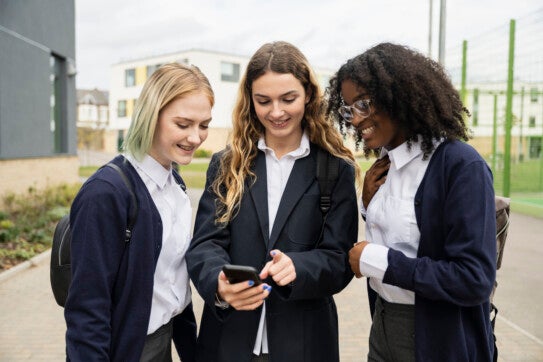Beyond Blanket Bans: A Thoughtful Approach to Phone Policies in Independent Schools

As phone restrictions become increasingly common across educational institutions, I’ve been observing how different schools approach this challenge. At Ruvna, we work with schools daily on safety and operational issues, giving us a unique perspective on how phone policies intersect with broader school operations and culture.
The conversation around student phone use has evolved significantly, and independent schools face particular considerations as they navigate these decisions. Each approach—whether restrictive, permissive, or somewhere in between—comes with distinct advantages and trade-offs worth examining.
The Independent School Context Matters
Independent schools face unique considerations. These communities are built on trust, individual freedom, and close relationships between students, faculty, and families. Importantly, families are making a deliberate choice to send their kids to these schools, often with specific expectations about educational philosophy and community values. When schools implement sweeping policies without community buy-in, they risk damaging the very foundations that make these schools special.
What I’m seeing across independent schools is troubling: They don’t fully understand why these policies are being implemented, and often the rationale being communicated focuses on surface-level benefits rather than addressing deeper concerns. Students haven’t bought into phone policies, especially at the high school level.
This highlights a critical challenge. We need to be honest with our students, and they deserve our transparency. When we communicate phone restrictions as ‘opportunities to enhance student connections’, students often see through messaging that doesn’t acknowledge the complexity of the issue. They deserve transparency about what we’re observing and the real reasons behind our concerns.
The Safety Paradox
Safety considerations add another layer of complexity. Schools must completely rethink emergency communication protocols when phones are removed from the equation. The “last text” concern from parents isn’t just anxiety—it’s a legitimate operational challenge that requires thoughtful solutions.
But here’s what I’ve observed: Schools are often treating phones as the primary problem when they’re actually amplifying existing issues. When students are disengaged, struggling with attention, or avoiding challenging work, phones become the escape route—but removing phones doesn’t address the underlying disengagement. Similarly, when classroom management is inconsistent or lessons lack relevance, phones become the obvious distraction, but the real issue isn’t the device itself.
This observation leads to important questions: Are schools implementing bans because phones are genuinely the source of learning disruption, or are they responding to symptoms while the root causes—pedagogical, cultural, or systemic—remain unaddressed?
What Bans Don’t Teach
Here’s a critical consideration: Bans by themselves don’t teach anything.
When schools remove phones entirely, they’re not teaching students how to responsibly use a technology that will be omnipresent in their adult lives. They’re simply changing the time window when students engage with these devices. The student who compulsively checks social media during lunch will likely do the same thing the moment they leave campus.
Technology isn’t going away. By denying that reality, schools do their students a disservice. Independent schools have always prided themselves on preparing students for the complexities of the real world—shouldn’t that include learning to navigate technology responsibly?
Addressing the Real Issues
My conversations with school leaders reveal an important consideration: Could phone bans sometimes be a response to challenges that require different solutions?
Student anxiety, depression, and stress existed long before smartphones. Independent schools can be high-pressure environments—students face stress about grades, college applications, and meeting high expectations. For some students, their phone serves as a de-stress tool, a lifeline to support systems outside the school.
When schools remove phones without addressing these underlying issues, they’re treating symptoms while ignoring the disease. Schools need to honestly examine what’s actually causing student distress in their communities.
A Better Approach: The Scalpel Method
Instead of blanket bans, I believe the best path forward is a targeted approach—thoughtful interventions that address specific problems without creating new ones.
This might mean:
- Contextual restrictions rather than all-day bans
- Teaching digital citizenship alongside setting boundaries
- Involving students in policy development to build genuine buy-in
- Addressing underlying stressors while managing technology use
- Maintaining emergency communication capabilities that parents and students can trust
I recently explored these challenges in depth with digital well-being expert Dr. Devorah Heitner, author of Growing Up in Public: Coming of Age in a Digital World. You can access our full webinar recording here where we discuss evolving safety protocols, building community trust, and practical approaches to digital citizenship in phone-restricted environments.
The Opportunity for Leadership
Independent schools have a unique opportunity here. They don’t have to follow public school trends if they don’t serve their communities. They can take a principled stand that balances individual freedom with community well-being.
The question isn’t whether phones pose new challenges or exacerbate old ones—they do both. The question is whether schools are willing to do the harder work of understanding those challenges and crafting solutions that align with their values and serve their students’ long-term interests.
Moving Forward Together
As I reflect on these ongoing conversations with school leaders, I’m reminded that the best solutions come from community engagement, not top-down mandates. Students, families, and faculty deserve policies that are thoughtfully crafted, clearly communicated, and genuinely aimed at creating better learning environments.
The phone policy debate is really a larger conversation about the role of technology in education and in students’ lives. Let’s make sure schools are having that conversation with the depth and nuance it deserves.
To my fellow school leaders: How are you approaching this challenge at your institution? Are you finding ways to teach responsible technology use while maintaining your school’s unique culture and values?
I’d love to hear your perspectives and continue this important dialogue. After all, the best insights come from those navigating these challenges every day.


